INDEX
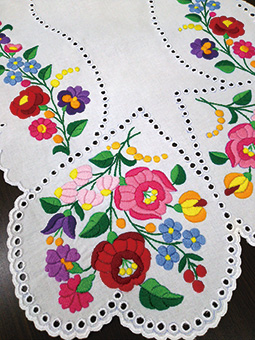
Hungarian embroidery in the Kalocsai hímzés style 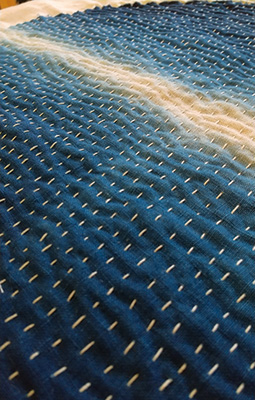
Sashiko 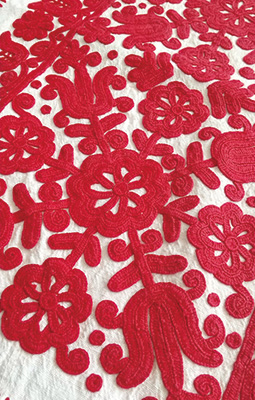
Hungarian embroidery in the Irasos hímzés style 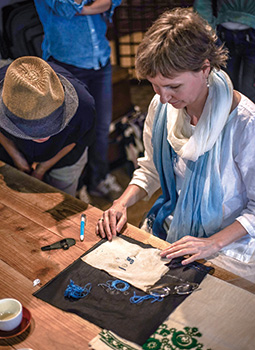
Hanga guides students at an embroidery class
October 2020
Hungarian Embroidery and Japanese Indigo Dyeing in Harmony
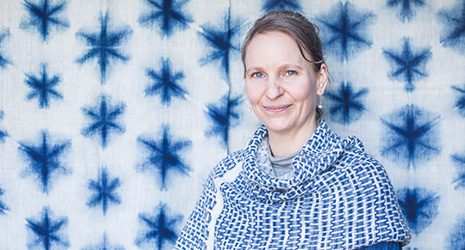
Hanga Yoshihara-Horvath, an embroidery artist living in Tokushima Prefecture, combines age-old Japanese indigo dyeing techniques with the embroidery techniques of her home country, Hungary, to create new fabric designs drawing on tradition.
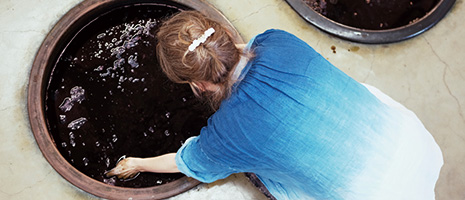
Ai-zome, or indigo dyeing, has been practiced all over Japan for centuries. The plant tade-ai (leaf indigo), which is the raw material for the dye, grows in many parts of the country. However, the indigo plant which grows in Tokushima Prefecture (formerly Awa) in Shikoku is held in particularly high regard for the vivid blue of the dye it produces. Known as Awa ai, the dye is made from tade-ai which benefits from Tokushima’s mild climate and fertile soil fed by the Yoshino River.
Hungarian native Hanga Yoshihara-Horvath is an embroidery and indigo dye artist living and working in Tokushima City. The fabrics Hanga makes using Awa ai are as light as a breeze and soft to the touch. Depending on the dyeing method used, the indigo imparts a variety of blues on her fabrics, from light blue to navy blue. Leveraging the diverse colors that indigo makes possible and techniques such as tie-dyeing* and stencil dyeing,** Hanga produces fabrics in many different patterns.

During a stay in the UK, Hanga learned about Japanese indigo dyeing from a book, and was impressed by the rustic beauty of sashiko,*** a traditional Japanese handicraft in which geometric patterns are embroidered onto indigo-dyed fabric. The experience inspired her to visit Japan, she says. Hanga attended art college in Hungary where she majored in knitting in the textile department. At last, in 2008, she had an opportunity to visit Japan as a scholarship student. She chose to study at Shikoku University to learn the traditional indigo dyeing techniques of Tokushima.
“We also have indigo dyeing in Hungary, but it involves the use of synthetic dye. In the past, imported natural indigo (West Indian indigo) was used, but that also partly involved the use of chemicals. In Japan, a completely chemical-free indigo dyeing technique has been preserved. This is wonderful,” says Hanga, who explains the dyeing technique as follows.

“Cut and dry indigo leaves, wet and stack them and stir them every few days to ensure that they evenly ferment. After a few months of natural fermentation, they become the indigo dye called sukumo.”
This dye is then further fermented by adding lye and sake to the pot. As the final step, cloth and thread are immersed in the pot filled with the finished dye.
Having experienced this entire process in a dye studio, Hanga wrote her thesis and earned a doctorate in Hungary.

After graduation, she married a Japanese man who studied indigo at the Tokushima Agriculture, Forestry, and Fisheries Technology Support Center. The family lives in satoyama countryside on the outskirts of Tokushima City, surrounded by nature.
In addition to her activities as an artist, Hanga organizes embroidery workshops for adults and children. In particular, her Hungarian embroidery course is well-received. Classes are held at a facility called “Aiyakazo” adjoining Ai-no-Yakata, a museum established in the renovated former home of an indigo-dyeing merchant.

In Hungary, different regions have preserved different embroidery cultures. Some of them have been inscribed on the UNESCO Intangible Cultural Heritage list. Hanga teaches Hungarian embroidery techniques in which her own grandmother was skilled, such as Sárköz hímzés,**** Irasos hímzés and Kalocsai hímzés. Hungarian embroidery techniques are characterized by the richness of their color, but Hanga uses only blue thread dyed with Awa ai. Her beautiful embroidery is a magical harmony of traditional Hungarian plant patterns and the indigo dye of Japan, which is similarly steeped in history.
“Both dyeing and embroidery take a lot of effort, but bring happiness in the process. This is also true for traditional Japanese indigo dyeing,” says Hanga. “Months are required for the indigo plant to grow and then ferment, and then the used dyes are returned to the soil. This cycle is pleasant.”
* The technique of making a pattern by partly tying a piece of cloth or using similar methods to apply pressure and prevent dyes from soaking into the cloth
** The technique of creating a pattern by controlling the spread of dyes using a paper stencil and glue
*** The act of embroidering cloth with geometric or other patterns
**** The traditional embroidery of Sárköz, a region west of the Danube River in Hungary. It is characterized by its unique stitches.

